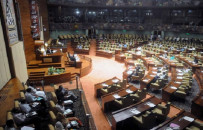CM trashes man-made disaster claims
Rejects report that people in power corridors diverted water to save their land

Sindh Chief Minister Syed Murad Ali Shah on Monday quashed the allegations of man-made disaster in the last monsoon rains and said, "The rains have taken its centuries old natural courses inundating the right and left side of the River Indus."
During the debate on the flood in Sindh Assembly, he referred to 17 centuries old data and said, "People are creating hype that PPP leaders and people sitting in power corridors have encroached upon the natural courses and diverted the water to save their own lands. If this was the case then why Kamber, Dadu, Sehwan on right side of the river and Badin, Mirpurkhas on the left side were inundated five centuries ago?"
The chief minister added that Pakistan emits less than one per cent of the world's warming planet and has paid huge prices for the greed of rich countries when it comes to the emission of greenhouse gases.
Presenting the figures in the house, the chief minister quoted the Pakistan Meteorological Department's prediction, which said, "There will be above normal rainfall in August."
According to the chief minister it was not above normal, but an unprecedented flood in the history of Sindh. "It was 800 per cent more than average." He said, "The situation became so intense during a period from August 17 to 26 when rain ravaged most of the areas with 1,288mm rain in Padidan of Naushero Feroz district, 779mm in Larkana, 614mm in Nawabshah and 500mm in Hyderabad division."
Comparing the situation in other provinces, the chief minister was of the view that in Azad Kashmir there was 2.6 per cent above average rain, while in Punjab it was 90 per cent above the average limit, in KP 45 per cent more rain was recorded. In Balochistan the rain was 500 per cent more than the average.
"Around 14 districts of Sindh were among most affected districts of Pakistan which received above average rains," he said adding that Tarbela Dam capacity is around 5.8 million acres feet, while 135 million acres feet rain water accumulated in Sindh.
Read Sindh to request Centre for probe into Arshad Shareef murder
"This figure excludes the water coming from Balochistan in Sindh," he said, adding that different crops standing on 3.8 million acres were damaged, 800 people lost their lives and more than two million houses were damaged out of which 80 per cent were mud-houses.
Referring to the official survey, the CM went on to say that 450,000 animals were perished, 8,500 roads of Rs111 billion were washed away with 20,000 government schools damaged fully or partially. "As many as 1,000 health facilities have had the big blow in the floods," he said, adding that the Sindh government with the help of the federal government has estimated total damage loss in the country at $16 billion.
"Prime Minister Shahbaz Sharif and foreign minister Bilawal Bhutto Zardari have taken the initiatives for organising a donor conference in January next year. Hopefully we'll get financial help for the rehabilitation process," he said, adding that around two million acres of land was under water on the right side of River Indus. Rainwater on around 1.76 million acres of land has been drained out. Similarly 1.2 million acres of land was inundated on the left side of the river where 50,000 acres of land is still under water.
Earlier, PTI MPA Fridous Shamim criticised the PPP government for its failure to deal with the flood situation and alleged that it was a man-made disaster. "The situation wouldn't have gone out of control had the PPP-led Sindh government learnt the lesson from 2010 floods," he said adding that billions of rupees earmarked for the development of dykes and canals are being bungled by government officials and ministers with no proper contingency plan to deal with the disaster-like situation.
The minister irrigation Jam Khan Shoro also briefed the house about his department's initiatives. Later, the speaker adjourned the session for the next day (Tuesday).
Published in The Express Tribune, December 6th, 2022.



















COMMENTS
Comments are moderated and generally will be posted if they are on-topic and not abusive.
For more information, please see our Comments FAQ